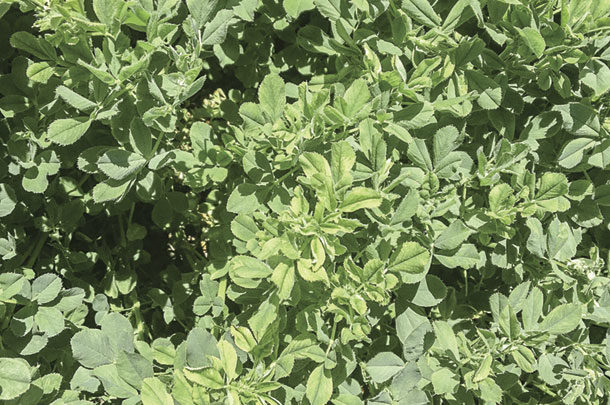Many herbicides for use on established alfalfa require application when alfalfa is dormant to avoid significant crop injury, greatly limiting the application window for control of summer-annual weeds and early and late-emerging winter annuals. The weed control spectrum of many herbicides labeled in alfalfa tends to be narrow, and most are effective on small weeds only. Very few established perennial weeds can be controlled with conventional herbicides in alfalfa.
Not surprisingly, alfalfa growers across the U.S. readily embraced Roundup Ready (RR) technology. Glyphosate offers excellent weed control, including a broad spectrum of grasses and broadleaves, both large and small. Even perennials such as dandelion and quackgrass are controlled by glyphosate. Glyphosate is inexpensive, has no crop rotation restrictions and is among the safest chemicals to the applicator and environment alike. Growers also like the flexibility of the RR system, which allows a glyphosate application at nearly any crop or weed growth stage.
Considerable research before and after the commercial release of RR alfalfa demonstrated essentially no perceptible crop injury. However, in 2014, Steve Orloff (University of California) received reports from several northern California growers of apparent injury to RR alfalfa following an application of glyphosate. To our knowledge, this was the first report of a significant crop injury problem related to RR alfalfa.
Over the next five years, similar injury was widely observed in production fields and in dozens of replicated research plots in California and Utah. Below is a summary of lessons learned about management practices to minimize injury.
Cold temperatures
Injury has mostly been observed when cold temperatures follow application. As alfalfa breaks dormancy after winter, new growth can be exposed to weeks or even months of frost. Research trials have shown the greatest injury is often associated with glyphosate application to alfalfa with significant regrowth followed by a hard frost within weeks of the application.
Glyphosate application to alfalfa just breaking dormancy often causes less injury, as alfalfa has little regrowth and more time to recover before first cutting. After first cutting, temperatures are usually high enough in most areas frost is no longer a problem. Fields with more severe freezes after application often have greater injury.
Injury symptoms
The earliest we have observed injury in the spring has been one to two weeks after application. Unlike typical herbicide injury, where each plant in the affected area is equally injured, injury symptoms from the combination of cold temperatures and glyphosate application on RR alfalfa appear on random plants and stems.
Some stems droop at the tip, forming what looks like a shepherd’s crook. Leaves can exhibit yellowing or chlorosis and become malformed. Over time, plants begin to show stunting, which ultimately leads to potential yield reduction.
Injury symptoms are very similar to frost damage. An untrained eye would have difficulty deciphering if the injury is caused solely by frost without an untreated area for comparison. A common trend associated with injury symptoms following glyphosate application is they become more pronounced with time, dissimilar to frost injury.
Long-term effects
No long-term consequences have been observed. Injury before first cutting does not continue to suppress yield in second or subsequent cuttings. Stand loss has not been detected.
Plant height
Application timing appears to be very important. First-cutting yield reduction has not been observed when alfalfa is sprayed at 2 inches tall or less. Alfalfa treated at 4 inches sometimes shows significant injury, which can influence first-cutting yield (usually at high glyphosate rates). Significant alfalfa injury and first-cutting yield reduction is often detected in fields treated when alfalfa is 6 to 8 inches tall when followed by a significant freeze.
First-cutting yield loss in our research trials and in commercial production fields has ranged from 0.3 to 1 ton per acre when glyphosate is applied to 8-inch-tall alfalfa in the spring and followed by freezing temperatures after application.
Glyphosate rate
Higher rates of glyphosate tend to produce greater yield loss in alfalfa than lower rates. When targeting an application at 2-inch-tall alfalfa, the winter-annual weeds present will be very, very small and easily controlled with a low rate (22 ounces per acre of Roundup PowerMax). The high rate (44 ounces) is not needed.
Stand age
Fields with older stands appear to be more susceptible to injury than younger stands.
Weed control
Glyphosate has no soil residual, so growers of RR crops are always concerned about weeds that emerge after application. Consequently, the traditional approach to weed management in post-dormant RR alfalfa is to delay application until “all” weeds have emerged.
Often this application occurs when alfalfa reaches 6 to 8 inches tall. In our research, weed control at first cutting was near perfect, regardless of whether the application was made to alfalfa when it was 2, 4, 6 or 8 inches tall. The earlier application timing does not reduce weed control. Most winter-annual weeds emerge in late fall, so they are already present when an application is made to 2-inch alfalfa. Weeds that emerge afterward tend to be insignificant in dense, healthy alfalfa stands due to intense competition from rapidly growing alfalfa.
Does this negate the value of RR technology?
Absolutely not. RR alfalfa is an outstanding tool for weed control in seedling alfalfa, managing weeds between cuttings and for controlling perennials like dandelion and quackgrass. It can also be an effective means of controlling winter-annual weeds prior to first cutting. In frost-prone areas, growers should be aware of this phenomenon and use management practices to avoid possible injury.
Best management practices
Crop injury can be avoided by applying glyphosate to RR alfalfa that is no greater than 2 inches tall. When a low rate of glyphosate was used (22 ounces per acre of Roundup PowerMax), application height can be extended to 4 inches. Our experience has shown weed control at the 2-inch alfalfa height is usually excellent. If a grower is concerned about weeds that emerge after glyphosate application, a soil-residual herbicide should be tank-mixed with glyphosate to extend control until canopy closure.
Extensive research on this topic is ongoing to help us better understand the mechanism responsible for injury. Knowing the underlying cause can help us further refine recommended management practices. Watch for blog postings on the California Alfalfa Workgroup homepage (alfalfa.ucdavis.edu) for the latest updates. ![]()
PHOTO: Roundup Ready injury symptoms look similar to frost symptoms in alfalfa with yellowing leaves drooping at the tip and stunting. Photo provided by Earl Creech from Steve Orloff’s collection.
Dan Putnam is an alfalfa and forage extension agronomist with the University of California – Davis. Rob Wilson is with the ANR Intermountain Research & Extension Center, Tulelake, California.

-
Earl Creech
- Assistant Professor - Extension Agronomist
- Utah State University
- Email Earl Creech












